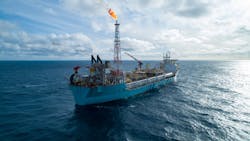Hurricane assessing more drilling, water injection at Lancaster west of Shetland
Dec. 18, 2020
Offshore staff
GODALMING, UK – Hurricane Energy has issued an update on production operations at the basement Lancaster oil field west of Shetland, including future drilling options.
Since Oct. 8, the early production test via the FPSO Aoka Mizu has mainly produced from one of the two wells, 205/21a-6. Current output from this well is around 12,300 b/d on artificial lift with a 23% water cut.
Early last month the company decided to limit production to around 12,000 b/d for reservoir evaluation and management purposes and the current level will likely be maintained for the time being.
Following initial results of a technical review announced in September, the company has conducted re-mapping to better define the field’s complex reservoir horizons, also reconstructing the reservoir simulation model to take into account the impact of sandstones onlapping fractured basement.
It has used the model to assess various near-term development options. One is a new production well in 2021 in the central ‘attic’ high of the field, which would involve re-entering and side tracking the existing 205/21a-7z well.
This could boost production capacity from 205/21a-6, accelerating production of existing reserves. Estimated cost is around $60 million: pending sanction early next year and securing a suitable rig and equipment, first production could follow from this well by late 2021.
Implementing a water injection program is also important to provide pressure support and to sweep oil toward the producing wells in the center of the field, Hurricane added, in order to lift recovery.
Analysis suggests injection into the northwest of the field could have the greatest effect. Assessment is currently focused on finalizing the well location, subsurface and FPSO modifications, operations planning and subsequent execution in 2022, at a likely cost of around $75 million.
12/18/2020
